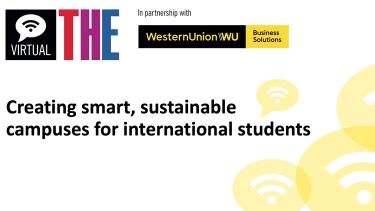
Source:
Western Union

China’s Belt and Road initiative is one factor in Asia’s becoming more competitive and attracting more international students
Universities in Western countries such as the UK, the US, Canada and Australia have a long tradition of welcoming international students from Asian countries, but increasingly the tide is moving in the opposite direction.
In recent years, Asian economies have made a concerted effort to build their higher education capacity. They have simultaneously encouraged more of the region’s population to study in their home countries and attracted more international students. As a result, China is now the third most popular destination for international students who previously would have studied in the UK, the US, Canada and Australia. In particular, China now attracts a growing number of students from South Korea, Japan, Thailand and Russia, as well as Pakistan and India.
These changes will pose challenges for Western universities as Asia creates more competition for international students. “We need to think about the impact of these shifting international student populations in countries such as the UK, the US, Canada and Australia,” says Skyler Webster, director of product management at Western Union Business Solutions. “Our advice is: don’t ignore your existing sources of students. The change will not happen overnight. It will be an evolution over time.”
Influential in China’s growth has been its Belt and Road Initiative (BRI), a government-led infrastructure project aimed at encouraging more collaboration between countries and regions along the so-called New Silk Road (NSR).
Italy is the latest prominent investor in the NSR initiative, and many EU-based institutions are now considering how and where they will build partnerships in China and other Asian countries, and how this will affect their domestic academic landscape.
“When creating alliances with Asian universities, Western institutions should look at several factors, including reputation, complementary services and aligning their value proposition,” says Webster. “There are many ways to structure an alliance, and choosing the right partner for your goals is important.”
Among the other Asian countries now focusing their energies on bringing more international students into their institutions, Hong Kong has pledged HK$20 billion (£1.9 billion) of new funding for university research, Singapore is placing an emphasis on continuous learning through its SkillsFuture scheme, and Japan aims to reach its target of 300,000 international students by 2020 with the help of English-taught courses and increased government funding.
“The latest international student mobility trends tell us that China and India will remain the top two send countries globally, but we are seeing expansive growth from Latin America, especially Colombia and Brazil, as well as African countries such as Nigeria,” says Webster. “Translated marketing materials, local payment preferences and relationships with local education agents can all help recruit international students. It’s also advisable to leverage relationships with alumni groups in overseas regions.”
Universities should also have processes in place that facilitate international student onboarding and create a positive experience. For example, how they accommodate the increasing need to accept student payments from other countries. Western Union offers a payment platform, GlobalPay for Students, that ensures funds arrive on time and without hidden charges. In many cases, payments can be tracked online or via email or text messages, meaning that administration departments in universities are no longer the primary source for tracking payments.
“It is our job to work closely with academic institutions across the world to offer payment services that ease the international payment process, from managing the risk of currency fluctuation to helping finance teams track and manage payments from international students,” says Webster.
While issues such as Brexit and populist governments may further disrupt the flow of international students, Webster notes that there may still be solutions closer to home.
“In the UK, 31 per cent of international student come from the EU,” she says. “In Canada, 3 per cent of international students come from the US. These are still prime markets for universities to continue to look to for international students.”
Western Union Business Solutions is supporting universities globally to provide financial infrastructure so that they can readily welcome academics and students from overseas with ease.
Find out more about Western Union Business Solutions for education.




